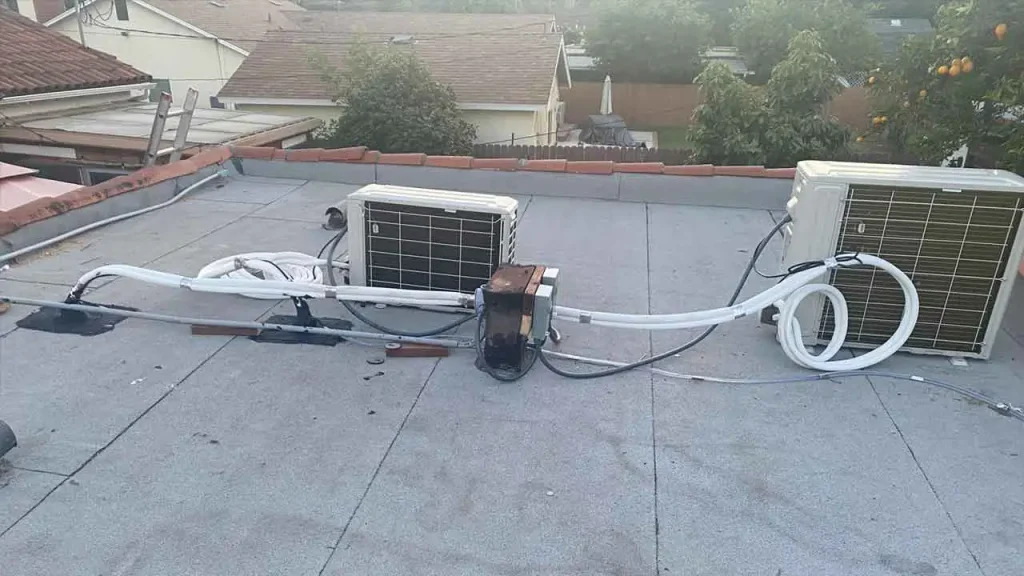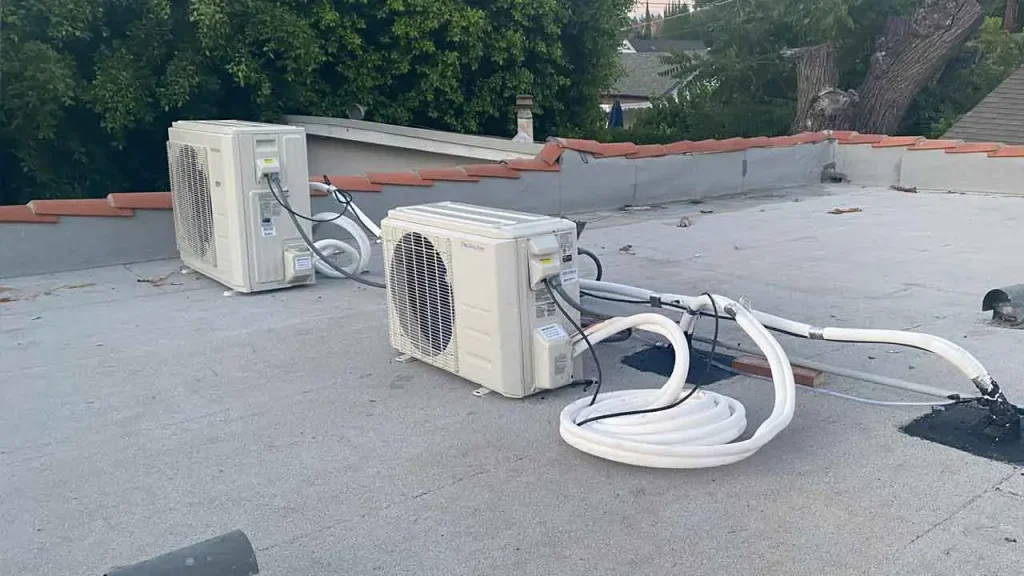Install Mini Split on the Roof, Benefits and Disadvantages, and Some Factors to Understand

Install Mini Split on the Roof and Decide Best Placement of Indoor & Outdoor
Have you ever considered installing a mini-split heating system on your roof? While it may seem like an unconventional choice, it’s a viable option for many homeowners. In this blog post, we’ll explore the pros and cons of installing a mini split on the roof and discuss important factors to consider before making your decision. So, if you’re ready to learn more about this unique heating solution and whether it’s right for you, read on!
Install Mini Split on the Roof of Heating and Coiling System
Install mini split on the roof heating system, also known as a ductless heat pump, is a versatile and efficient way to regulate the temperature in your home. Unlike traditional HVAC systems that rely on ductwork to distribute air, mini splits consist of 2 main components: an outdoor condenser unit and one or more indoor air handling units.
The outdoor condenser unit houses the compressor and refrigerant while the indoor units are responsible for delivering conditioned air directly into specific rooms or areas. This allows for individual temperature control in each space without the need for additional ductwork.
One of the key advantages of a mini-split system is its energy efficiency. By eliminating duct losses, these systems can save you money on your energy bills while reducing environmental impact. They also feature advanced technologies like variable-speed compressors and smart thermostats that optimize performance based on demand.
Installation of a mini-split system is relatively easy compared to other heating options. Since there’s no need for extensive ductwork, it can be installed quickly with minimal disruption to your home. Plus, many models offer flexible installation options – from wall-mounted units to ceiling-recessed ones – allowing you to find the best fit for your space.
Another benefit worth mentioning is their ability to fit in different places within your home. Whether you have limited wall space or prefer a discreet installation, mini splits offer flexibility when it comes to placement options. You can even install them on ceilings if that better suits your needs!

Not only are mini splits economically friendly due to their energy-efficient operation, but they also provide excellent heat regulation in individual rooms. With zoning capabilities offered by these systems, you have full control over which areas receive heating or cooling at any given time. While there are numerous advantages associated with installing a mini-split heating system on your roof.
Important Part Install Mini Split on the Roof
When it comes to installing a mini split heating system, one common question that arises is whether there is a roof mount bracket available. The good news is that yes, there are indeed roof mount brackets designed specifically for mini splits.
A roof mount bracket serves as a secure and stable platform to install your mini split unit on the roof of your building. It provides extra support and ensures stability, especially in areas with high wind or seismic activity. These brackets are typically made from durable materials like steel or aluminum, ensuring long-lasting performance even in harsh weather conditions.
Roof mount bracket offers several advantages.
First and foremost, it allows you to maximize space utilization by placing the mini split unit on the otherwise unused area of your roof. This can be particularly beneficial if you have limited indoor space or prefer not to compromise wall aesthetics.
Additionally, mounting the mini split on the roof helps protect it from potential damage caused by debris accumulation or accidental contact with objects indoors. It also reduces any noise generated by the unit since it’s located outside rather than inside your living spaces.
Having a dedicated roof mount bracket for your mini split installation provides peace of mind knowing that your system is securely mounted while optimizing both functionality and aesthetics within your home or commercial space.
Advantages Of Install Mini Split on the Roof
Mini split ductless heat pumps offer numerous advantages including precise temperature control in individual rooms, high energy efficiency levels, easy installation process, flexible placement options, and long-term cost savings.
01. Heat & Coil Temperature In Individual Rooms
One of the key advantages of installing a mini split heating system on your roof is the ability to regulate heat in individual rooms. With traditional HVAC systems, it can be difficult to achieve consistent temperatures throughout your home. Some rooms may end up being too hot while others are too cold. But with a mini-split system, you have the flexibility to set different temperatures for each room or zone. This means that everyone in your household can enjoy their preferred level of comfort without compromising on energy efficiency.

Say goodbye to arguments over thermostat settings! Whether you want your bedroom cool and cozy for a good night’s sleep or prefer a warmer temperature in the living room during chilly winter evenings, a mini split allows you to customize each space according to your liking. The individual control feature also comes in handy when certain areas of your home aren’t being used regularly. You can simply adjust the temperature accordingly, saving energy and reducing utility bills.
By ensuring optimal comfort and energy savings at the same time, mini splits provide an excellent solution for personalized heat regulation in every room of your house.
02. Save Electricity Consume
When it comes to energy efficiency, mini split ductless heat pumps are a top choice. These systems are designed to provide efficient heating and cooling without wasting energy or driving up your utility bills.
One of the main reasons why mini splits are so energy-efficient is their ability to heat or cool individual rooms separately. Unlike traditional HVAC systems that rely on ductwork to distribute air throughout the entire house, mini splits can be installed in each room, allowing you to control the temperature independently.
Additionally, mini split heat pumps use advanced technology such as variable speed compressors and inverter technology. These features allow the system to adjust its output based on the specific needs of each room, resulting in more precise temperature control and improved efficiency.
By investing in a mini-split ductless heat pump for your roof installation, you can enjoy greater energy efficiency while keeping your home comfortable all year round.
03. Easy To Setup on the Roof
One of the major advantages of a mini-split ductless heat pump is its ease of installation. Unlike traditional HVAC systems that require extensive ductwork, a mini-split can be installed quickly and with minimal disruption to your home.
The installation process typically involves mounting the indoor and outdoor units, connecting them with refrigerant lines, and wiring them to a power source. This can often be done in just a few hours by an experienced HVAC technician. Because there is no need for ductwork, you also have more flexibility in where you install your mini split. You can place the indoor unit on any wall or ceiling that suits your needs and aesthetics.

Additionally, most mini splits come with easy-to-follow installation instructions, making it possible for some homeowners to tackle the job themselves if they are confident in their DIY skills. The ease of installation makes mini splits an attractive option for those looking to upgrade their heating system without major construction work or expensive modifications.
04. Fit The Mini Split In Different Places
One of the great advantages of a mini-split ductless heat pump system is its versatility when it comes to installation. Unlike traditional HVAC systems, which require extensive ductwork and limited placement options, mini splits can be installed in various locations within your home.
Furthermore, the compact size of mini splits makes them suitable for fitting into different places within your home. Whether you have limited wall space or prefer a discreet installation option, there’s always a way to accommodate a mini split without compromising aesthetics.
From high up on the walls near the ceiling or low down near the floor – whatever works best for you! The ability to fit these units in various places ensures that they seamlessly integrate into any interior design style while providing optimal comfort throughout your living spaces.
05. Save your Economic Cost
When it comes to choosing a heating system for your home, considering the economic impact is crucial. Mini split ductless heat pumps are known for their energy efficiency and cost-effectiveness. Here are some reasons why mini splits are economically friendly. Opting for a mini-split system provides both short-term and long-term economic benefits.
Mini-splits offer zoned heating, allowing you to control the temperature in individual rooms. This means you can save energy by only heating the rooms that need it, rather than wasting energy on empty spaces. With their long lifespan and minimal maintenance requirements, mini-split systems offer long-term savings. They typically have fewer components that can break down or wear out over time compared to traditional HVAC units.
Disadvantages Of Install Mini Split on the Roof
Like any HVAC system, regular maintenance is necessary to keep the unit running efficiently and prevent issues from arising. This includes cleaning or replacing filters, checking refrigerant levels, and inspecting the components for wear and tear. While this may not be a deal-breaker for most homeowners, it does require some ongoing effort.
Some people may find this unsightly or disruptive to their interior design aesthetic. The installation process itself can also add to the overall expense if professional help is required. It’s important to weigh these disadvantages against the advantages before making your decision about installing a mini split on your roof.
01. Maintenance of Any Type of Demange
When it comes to the maintenance of a mini-split system installed on the roof, there are a few things to keep in mind. First and foremost, regular cleaning is essential to ensure optimal performance. Dust and debris can accumulate on the outdoor unit, hindering its efficiency. Additionally, checking and replacing air filters regularly will prevent clogs and improve indoor air quality.
Another aspect of maintenance is inspecting the refrigerant levels. Low refrigerant can lead to decreased cooling or heating capacity, so it’s important to monitor this aspect regularly. Additionally, checking for any leaks in the system is crucial as they can impact its overall performance.
While regular maintenance may require some effort and investment of time or money upfront, it ensures that your mini-split system remains efficient and reliable for years to come!
02. Aesthetics
When it comes to installing a mini split on the roof, one factor that you need to consider is aesthetics. While mini splits are known for their compact size and sleek design, having them mounted on your roof may not always be the most visually appealing option.
The outdoor unit of a mini split can be quite noticeable when placed on top of your roof. Depending on the location and layout of your home, this may affect the overall aesthetic appeal. Some homeowners prefer to keep their roofs clean and free from any visible equipment.
However, despite these concerns about aesthetics, there are solutions available. One option is to install a mini split roof mount bracket specifically designed for this purpose. This bracket allows for secure mounting while minimizing any visual disturbances.
03. High Investment Money
Cost is one of the main factors to consider when deciding whether or not to install a mini split on your roof. While mini splits can be an efficient and effective heating and cooling solution, they do come with a higher price tag compared to traditional HVAC systems.
The initial cost of purchasing and installing a mini-split system can be quite expensive. Not only do you need to purchase the unit itself, but you also have to factor in installation costs, which may require professional help. This can add up quickly and may deter some homeowners from choosing this option.
While cost may pose a challenge for some homeowners, it’s important to weigh it against the advantages offered by mini-split systems before making a final decision on whether or not to install one on your roof.
Remind Some Important Thing When Installing A Mini Split On Roof
When it comes to installing a mini split on your roof, there are a few important factors you need to consider. Some of the most important issues to understand when installing a mini split on the roof.
01. Roof Slope
One important factor to consider when installing a mini split on the roof is the slope of your roof. The slope, or pitch, of the roof, can affect how well the unit functions and how efficiently it drains water.

A steeply sloped roof may not be ideal for installing a mini split as it can make installation more challenging. It may require additional mounting brackets or supports to ensure stability and proper drainage. On the other hand, a flat or low-sloped roof may be easier to work with and provide better support for the unit.
The angle of the roof also affects how rainfall and snow accumulation are dispersed. If you live in an area with heavy precipitation, a steeper roof slope can help prevent water from pooling around the unit. This is essential as excess moisture can lead to corrosion and damage over time.
02. Fresh Air UV Rays Effect
Direct UV rays can have a significant impact on the performance and lifespan of a mini-split system installed on the roof. The intense heat and radiation from the sun can cause damage to the unit, affecting its efficiency and overall functioning.
UV rays can cause the plastic components of the mini-split system to degrade over time. This degradation can lead to cracks, warping, or discoloration of parts, which in turn may result in air leaks or reduced airflow. Additionally, exposure to direct sunlight can increase internal temperatures within the unit itself, potentially leading to overheating and decreased performance.
Understanding how direct UV rays affect a mini-split system is vital when considering installation on your roof. Taking necessary precautions and implementing appropriate protection measures will ensure optimal performance and extend its lifespan despite constant exposure to sunlight.
03. Use A Mini Split Roof Mount Bracket
One important factor to consider when installing a mini-split on the roof is the use of a mini-split roof mount bracket. This bracket provides secure and stable support for your unit, ensuring it stays in place even during inclement weather conditions.
By using a roof mount bracket, you can alleviate any concerns about the stability of your mini-split system. It helps distribute the weight evenly and prevents any potential damage to your roof or surrounding structures.
Investing in a quality mini split roof mount bracket is crucial for ensuring the longevity and efficient operation of your system. By utilizing this accessory properly, you can enjoy all the benefits of having a mini split without compromising on safety or effectiveness.
FAQs
Conclusion
While it is possible to install a mini split heating system on the roof, there are several factors to consider before making this decision. The advantages of a mini-split ductless heat pump, such as heat regulation in individual rooms, energy efficiency, easy installation, versatility in placement options, and environmental friendliness make it an attractive choice for many homeowners.
However, there are also some disadvantages to keep in mind. Maintenance requirements can be higher compared to traditional HVAC systems, and the aesthetics of having an outdoor unit on your roof may not appeal to everyone. Additionally, the initial cost of purchasing and installing a mini-split system can be significant.
Before deciding to install a mini split on your roof, it’s important to evaluate factors such as the slope of your roof and the potential direct exposure to UV rays. Using a proper mini split roof mount bracket can help ensure stability and longevity. Remember that proper installation by qualified technicians is crucial for optimal performance and longevity of your system. By considering all these factors carefully before making a decision, you’ll be able to determine if installing a mini split on the roof is right for you.






